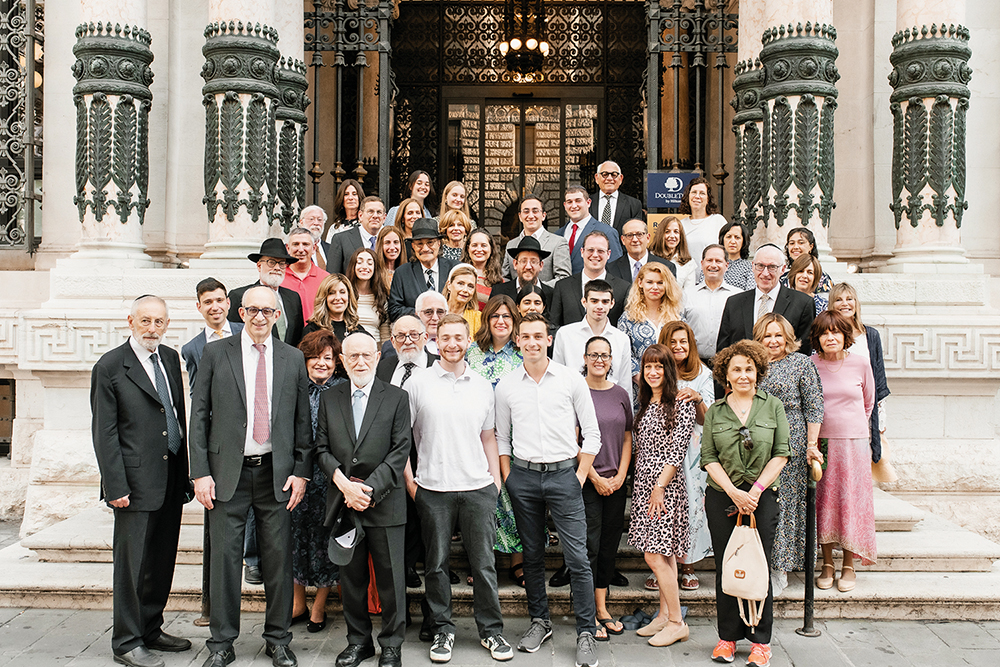History comes to life for Touro Students on 10-day trip to Northern Italy.

Get this: A flyer for the excursion of a lifetime lands in your lap on a typical Monday morning while you are sitting in the cafeteria at Touro’s Lander College for Women. A chance to go on a wine tasting adventure in Tuscany and a cheese tour in Parma was enough to get me to sign up for Touro University’s 10-day Northern Italy trip. The cherry on top? Earning college credits while doing so. But what may have begun for some students as a superficial intrigue about the cuisine and shopping of the Alpine region of Italy, quickly transformed into an experience enriched with a study of Italian Jewry, a thorough account of the history and resilience of my people, and yes, the best pasta in the world.
Throughout our travels to cities like Milan, Venice, Trieste, Florence and Padua, my fellow students and I heard riveting lectures from Touro’s very own faculty, each with a unique voice in exploring the rich history, jaw-dropping scenery and mesmerizing architecture that surrounded us. In his lecture titled, “Medical Education for Jewish Studies,” Touro University president, Dr. Alan Kadish,recounted the story of a Jewish medical student who left Shacharit on the morning of Rosh Hashanah, the Jewish new year, in order to pass his medical exams, making it back in time for the Shofar blowing. Touro Professor, Dana Fishkin, an expert in medieval Jewish history and literature, described at length the role of Jews in Italy’s Enlightenment movement, stressing the notion of empiricism–that is, that all knowledge originates through experience— an apt philosophy for us pilgrims discovering our Jewish heritage through first-hand accounts and exposures.
Unveiling the Dichotomy of a Hopeful Present Amidst a Daunting Past
Fresh off the plane, we dropped off our bags and headed towards the Holocaust Museum, only to get off the bus and witness an antisemitic slogan sticker plastered across a pole. The tallest of us peeled it off immediately, and we remained silent. To be sure, we were embarking on a journey to study the history of the persecution our ancestors faced, but were forced for a moment to reckon with its legacy in the present.
Indeed, the trip was paved with discovery. We toured the Museum of Printing in Soncino, which disseminated major Jewish works, then learned of the 1553 papal edict of Pope Julius III ordering the burning of the Talmud. We devoured hand-tossed pizza on a boat from Venice to Murano, where we took a glass-blowing workshop followed by a walking tour through the desolate Cannaregio quarters once bustling with Jewish life but now desolate. We sported our Whisper listening earpieces as we ducked into boutiques to buy cheesy hats and magnets. We prayed in countless synagogues, older than Touro itself, throughout different cities, captured their stained glass windows, impossibly vaulted ceilings and marble floors, only to learn of their obsolescence in the 21st century. As outsiders we witnessed the return of ghosts we thought had disappeared forever in a concentration camp in Fossoli. And as Jews we wept for those on “The Wall of Names” across the screen of the Shoah Memorial of Milan. We bore witness to the history of the persecution of the Jews, yet in so doing were living and breathing testaments to Jewish survival against all odds.
Italian Jewry’s Continued Yearning for Home
I carry with me the words of Dr. Israel Singer, who spoke at dinner on our final night in Italy: “We see no roots,” he said, noting a lack of Jewish foundation in the region, and beholding remnants of a civilization that yearned for home. Undeniably, Italian Jewry remained inextricably linked with the land of Israel, the heartbeat of the nation forever facing eastward.
In the Fossoli concentration camp, my fellow explorers and I saw rows and rows of barracks, their very architecture revealing layers of history chipped away. Our tour guide pointed out the importance of the structures standing as a physical manifestation of their past, first as transit camps, then prisoner of war detainment centers and ultimately foreign refugee centers, the differing layers visible so we may see all that transpired in the act of rebuilding. I thought to myself that we too have our history ingrained in the fabric of our existence. I was not discouraged by the once Jewish hotspots now bleak and barren, rather I left inspired by the life we have rebuilt in our homeland and the intrinsic desire of Italian Jewry to thrive again. We said goodbye at the MXP airport with mixed emotions, but believing that our journey was another rung on the ladder towards a better understanding and appreciation of Italian Jewry in the past and present.
Nini Schulman is a sophomore majoring in accounting at Touro’s Lander College for Women.












